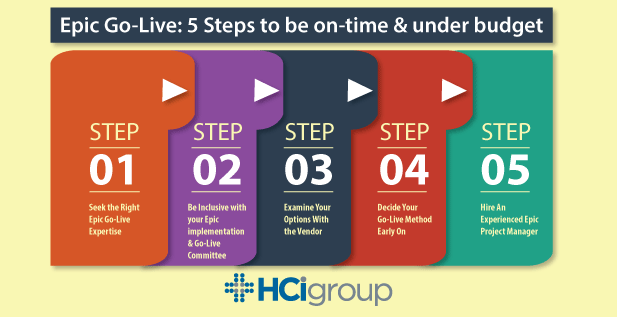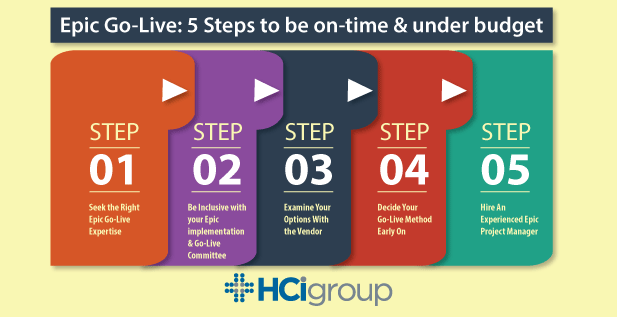Epic Go-Live: 5 Steps to be On-Time & Under Budget


Whether you are planning a big-bang Epic Go-Live or a phased ambulatory roll-out, there are some tried and true tips to ensure a smooth activation. In this blog post, we look at the importance of Epic Go-Live Planning. Include the following steps in your planning:
1) Select the Right Epic Go-Live Expertise
It all starts with a great plan. Assessing readiness and determining the best Epic Go-Live partner are the most critical factors to consider during planning. This partnership will affect all other decisions that are made from this point forward.
Developing an all-inclusive project plan that includes tasks, resources, and milestones will determine if the timeframe is obtainable with current resource allocation, or if outside help is required. The deliverables from this step are essential for maintaining an on time and under budget Epic implementation.
Realize that you will learn from the experience and knowledge of others who have implemented Epic, including peers from provider organizations who had similar perspectives on, and responsibilities in, the process. Look to professional organizations for resources and guidance. Retain consultants and outside implementation professionals whose expertise compounds from a multitude of experience in implementing Epic.
2) Be Inclusive with your Epic Implementation & Go-Live Committee
Your steering committee should represent your organization’s diversity. For example, do not emphasize IT over clinicians, or vice versa. They must travel down the path together.
Accordingly, different providers be represented, such as nurses, physicians, pharmacists and laboratory technicians. Non-clinicians, like accountants, analysts, billers, and schedulers must also be included. Include managers and non-managers as well. The front-line end users who will use the system every day should be involved in every phase, from application choice through implementation and beyond. The process doesn’t end with “Go-Live.” An Epic Implementation becomes an ongoing day-to-day part of operational life.
Diversify further as you move from your broad steering committee to specific advisory teams. Incorporate nurses from the emergency department, obstetrics/gynecology, and pediatrics, for example, when determining how to implement a new system based on work flows. Plan their involvement ahead so that you can maintain care levels by scheduling clinical staff appropriately.
3) Examine Your Options With the Vendor
Push vendors for case studies and references, specifically from organizations similar to yours whose projects were alike in scope. Schedule site visits at hospitals whose environment would be valuable to observe. Vendors often are happy to arrange visits to their best sites. Press for access to one where you can get unvarnished opinions.
Vet vendors’ customization processes. Will they connect their EHR to your legacy systems? If so, what will it cost? And, how long will it take? Can the physician group responsible for your largest admission base interface with the vendor’s system? If not, will the vendor help connect them? What is the vendor’s process for upgrades? And, what do they cost? These are just a few questions--the more details you get, the more informed the decision you can make.
4) Decide Your Go-Live Method Early On
Set out the timeline and milestones. Implementations typically take 16 to 24 months. Include targets for each phase along the way. Make them measurable and obtainable, incorporating every phase from design to Go-Live.
Choose your Go-Live method. Will you go all in with a Big Bang, putting every department and user online at once? Or, will you opt instead for a phased approach that staggers activations by departments and users? Each type has pros and cons, depending on your organization.
Evaluate which type of Go-Live works best for your budget, culture, and care environment. You may find it more efficient to staff for one comprehensive push that brings the entire organization online immediately, as opposed to using a phased approach that requires prolonged support staffing and monopolizes meeting space. Conversely, you may go for the phased Go-Live so that your users can get more personalized support to ease their transition. There is no single right or wrong method.
5) Hire An Experienced Epic Project Manager
Appoint an Epic project manager to manage the deadlines, mitigate the risks, and serve as the project’s champion. They must secure and maintain commitments across the organization, from the C-suite to the ground floor. Hospital executives cannot simply delegate their implementation duties, as end-users will be looking to them for leadership. Similarly, physicians cannot be excluded from the evaluation phase and then expected to start using the system that others chose.
Development of a strong, honest, and consistent communication plan is imperative. Begin with “why” you are doing this. Remember the bottom line is “the patient in the bed.” Make it a point to discuss efficiency (“ no longer looking for charts”), safety (“up-to-date, real-time diagnostic results available to make on-the-spot care decisions) and communication (“now able to communicate with other providers to prevent duplicate testing and potential adverse treatment regimens and combinations”). Convey the benefits for each individual user group and for your organization as a whole—and reinforce them whenever possible.
Keeping communication clear and processes smooth are essential for a successful Epic Go-Live. Epic consultants who have been through Go-Lives are invaluable in helping you navigate potential pitfalls, like understanding how to create procedures to coordinate lab tests, prescriptions and prescription fulfillment for medications.
Find somebody who can bring a repository of such lessons learned in the industry and resolve these issues four to six weeks before your Epic Go-Live. The sooner you start, the better you will finish.
To effectively plan and allocate resources, you must understand the current Health System’s technological state. By understanding and documenting the current technological state, you are better prepared to reach the required future state. The documentation of the current state technology, along with a clear understanding of your EHR requirements, will allow for a detailed gap analysis. This gap analysis is used to develop a detailed plan of specific tasks that are required to meet the desired level of technology in the timeframe allocated. Setting an achievable timeframe and a reasonable number of tasks helps determine if the current resource pool is sufficient, or if outside assistance is required.
To subscribe to our blog and stay up-to-date on the latest healthcare IT expertise, click below.

